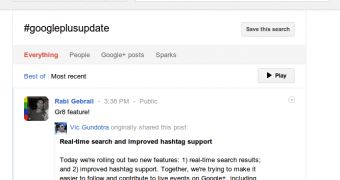Google has been working on improving Google+ ever since it launched it and has been releasing small tweaks, fixes and new features constantly. Very recently, Google introduced a search feature for Google+, which had been missing initially, quite a big oversight.
But it's moving faster now, it's already improving on it and has enabled real-time search on the site.
This allows users to keep up with a subject without actually doing anything, as soon as a more recent result is available, it gets pushed to the search page.
At the same time, also courtesy of the new search feature, Google is enhancing the use of hashtags on Google+ as they now automatically link to a search results page for whatever term is used in the hashtag.
"Today we're rolling out two new features: 1) real-time search results; and 2) improved hashtag support. Together, we're trying to make it easier to follow and contribute to live events on Google+, including breaking news, sporting events, and many others," Vic Gundotra, one of the two people leading the Google+ effort, wrote.
By now, you should be fairly familiar with real-time search features. By default, as soon as a new result comes in, it pushes everything else down the list. However, users can hit the 'Pause' button if things are moving too fast.
This way, the user, when notified of newer results, has to manually click to update the search results list with the new entries.
This may seem like a bit more work, but it makes it much easier to keep up with a results stream, especially for something that is very heavily debated.
"People have long used hashtags to mark their posts with certain topics -- just ask our very own +Chris Messina, hashtag inventor. You don't have to use hashtags on Google+ (search works fine without them), but when you do, we'll automatically link to search results," Gundotra explained.
For the hashtags, Google+ has also taken inspiration from Twitter and the feature now works pretty much identically as it does on Twitter.

 14 DAY TRIAL //
14 DAY TRIAL // 